Organizational Behavior Theories, Problems & Interventions Essay
VerifiedAdded on 2023/06/10
|9
|2257
|132
Essay
AI Summary
This essay delves into the theories of organizational behavior, including Human Relations, Decision Making, and Servant Leadership, examining their implications for managing employees and fostering a positive work environment. It identifies potential organizational problems such as employee dissatisfaction, poor communication, and lack of diversified practices, proposing proactive managerial interventions to address these issues. The essay also touches upon current developments in organizational behavior, such as industrial advancements and the application of scientific management principles. It emphasizes the importance of understanding and applying organizational behavior theories to improve employee productivity and organizational profitability, highlighting the need for adaptive managerial approaches in the contemporary business environment. Desklib provides access to similar essays and study tools for students.
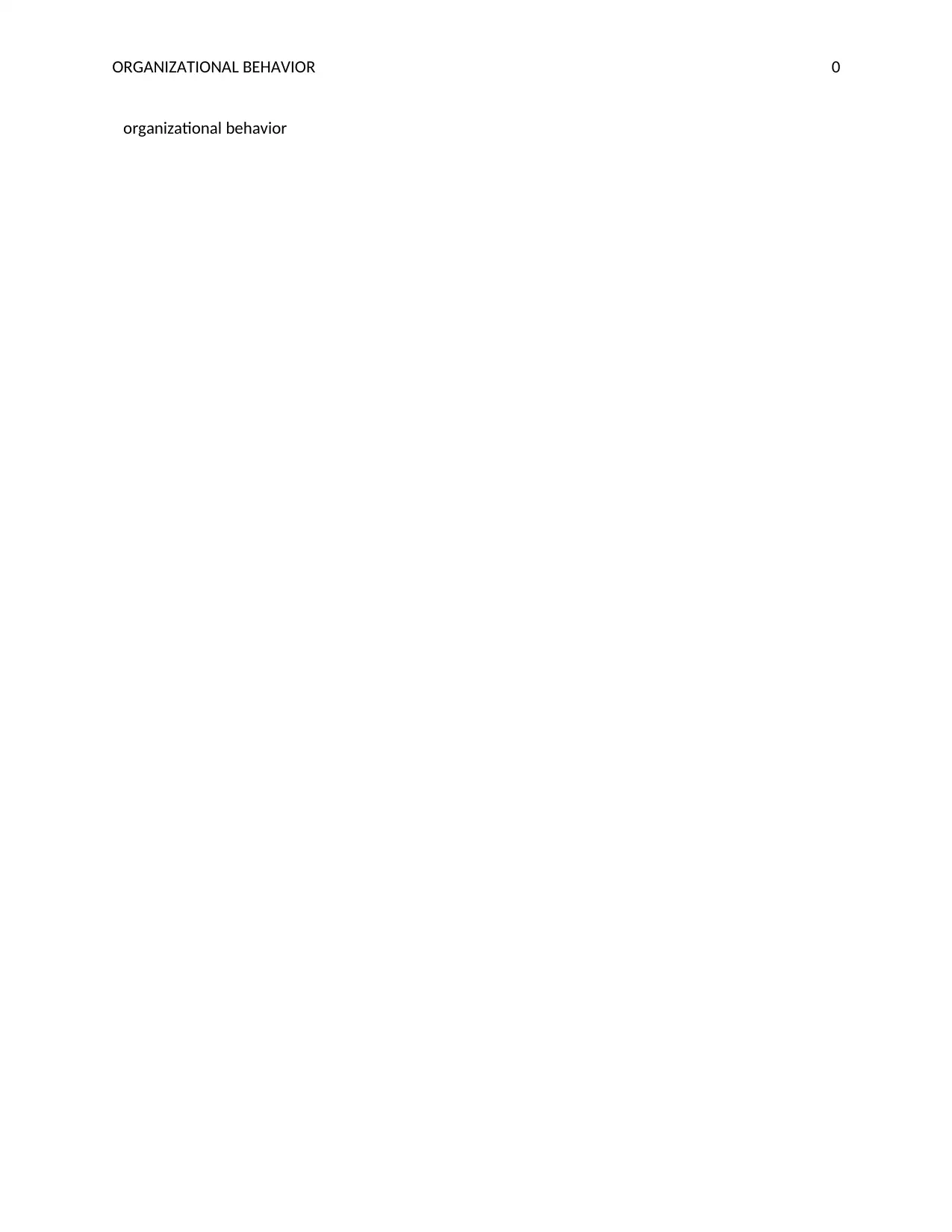
ORGANIZATIONAL BEHAVIOR 0
organizational behavior
organizational behavior
Paraphrase This Document
Need a fresh take? Get an instant paraphrase of this document with our AI Paraphraser
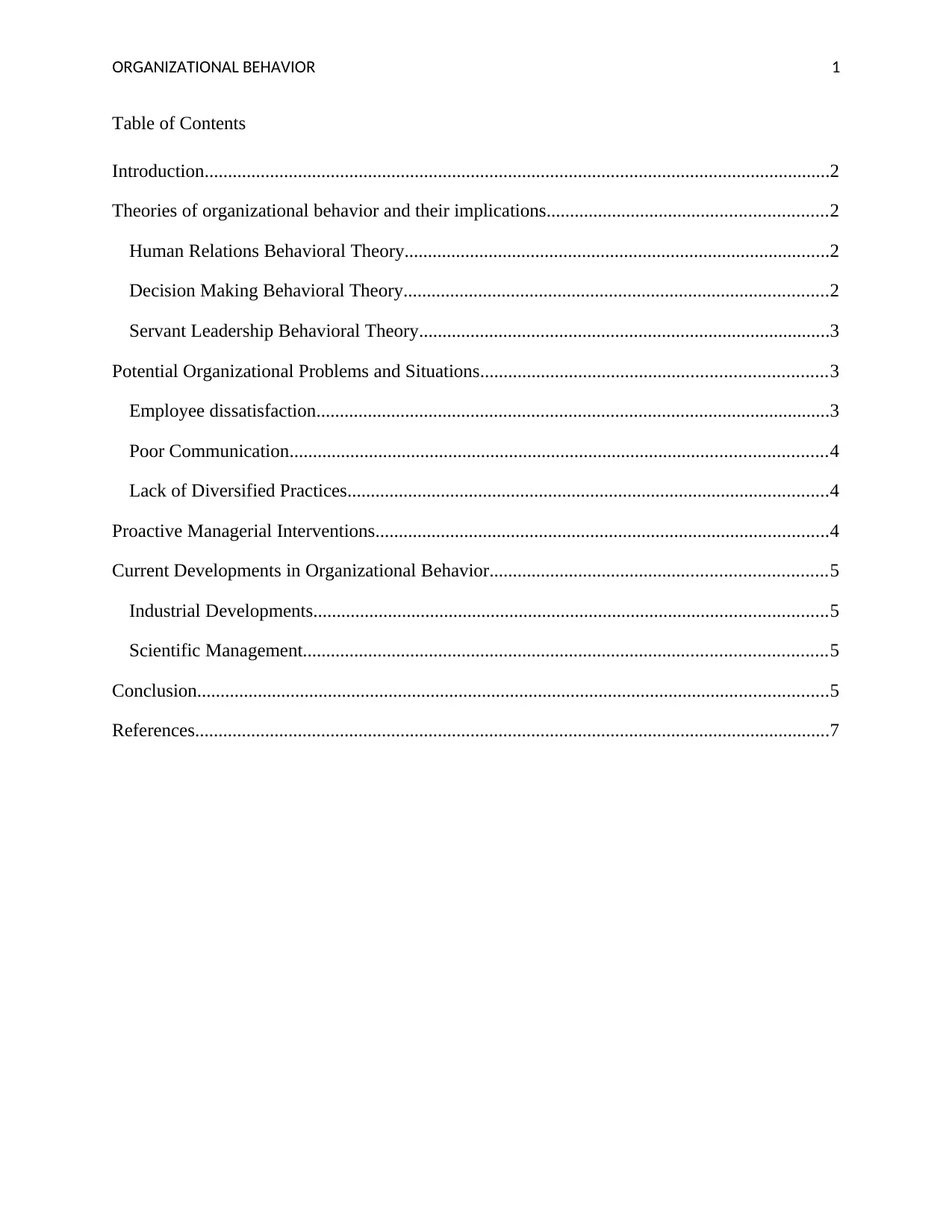
ORGANIZATIONAL BEHAVIOR 1
Table of Contents
Introduction......................................................................................................................................2
Theories of organizational behavior and their implications............................................................2
Human Relations Behavioral Theory...........................................................................................2
Decision Making Behavioral Theory...........................................................................................2
Servant Leadership Behavioral Theory........................................................................................3
Potential Organizational Problems and Situations..........................................................................3
Employee dissatisfaction..............................................................................................................3
Poor Communication...................................................................................................................4
Lack of Diversified Practices.......................................................................................................4
Proactive Managerial Interventions.................................................................................................4
Current Developments in Organizational Behavior........................................................................5
Industrial Developments..............................................................................................................5
Scientific Management................................................................................................................5
Conclusion.......................................................................................................................................5
References........................................................................................................................................7
Table of Contents
Introduction......................................................................................................................................2
Theories of organizational behavior and their implications............................................................2
Human Relations Behavioral Theory...........................................................................................2
Decision Making Behavioral Theory...........................................................................................2
Servant Leadership Behavioral Theory........................................................................................3
Potential Organizational Problems and Situations..........................................................................3
Employee dissatisfaction..............................................................................................................3
Poor Communication...................................................................................................................4
Lack of Diversified Practices.......................................................................................................4
Proactive Managerial Interventions.................................................................................................4
Current Developments in Organizational Behavior........................................................................5
Industrial Developments..............................................................................................................5
Scientific Management................................................................................................................5
Conclusion.......................................................................................................................................5
References........................................................................................................................................7
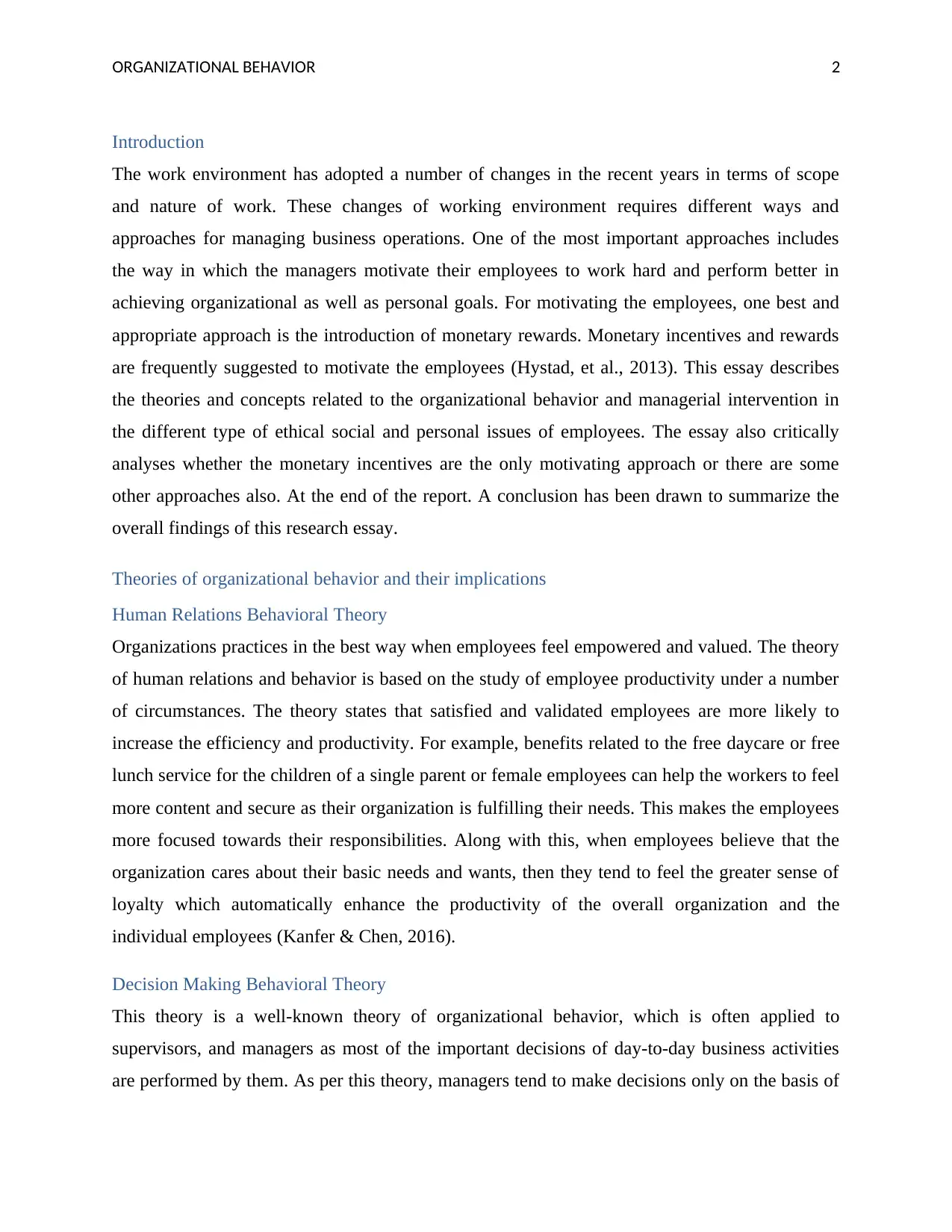
ORGANIZATIONAL BEHAVIOR 2
Introduction
The work environment has adopted a number of changes in the recent years in terms of scope
and nature of work. These changes of working environment requires different ways and
approaches for managing business operations. One of the most important approaches includes
the way in which the managers motivate their employees to work hard and perform better in
achieving organizational as well as personal goals. For motivating the employees, one best and
appropriate approach is the introduction of monetary rewards. Monetary incentives and rewards
are frequently suggested to motivate the employees (Hystad, et al., 2013). This essay describes
the theories and concepts related to the organizational behavior and managerial intervention in
the different type of ethical social and personal issues of employees. The essay also critically
analyses whether the monetary incentives are the only motivating approach or there are some
other approaches also. At the end of the report. A conclusion has been drawn to summarize the
overall findings of this research essay.
Theories of organizational behavior and their implications
Human Relations Behavioral Theory
Organizations practices in the best way when employees feel empowered and valued. The theory
of human relations and behavior is based on the study of employee productivity under a number
of circumstances. The theory states that satisfied and validated employees are more likely to
increase the efficiency and productivity. For example, benefits related to the free daycare or free
lunch service for the children of a single parent or female employees can help the workers to feel
more content and secure as their organization is fulfilling their needs. This makes the employees
more focused towards their responsibilities. Along with this, when employees believe that the
organization cares about their basic needs and wants, then they tend to feel the greater sense of
loyalty which automatically enhance the productivity of the overall organization and the
individual employees (Kanfer & Chen, 2016).
Decision Making Behavioral Theory
This theory is a well-known theory of organizational behavior, which is often applied to
supervisors, and managers as most of the important decisions of day-to-day business activities
are performed by them. As per this theory, managers tend to make decisions only on the basis of
Introduction
The work environment has adopted a number of changes in the recent years in terms of scope
and nature of work. These changes of working environment requires different ways and
approaches for managing business operations. One of the most important approaches includes
the way in which the managers motivate their employees to work hard and perform better in
achieving organizational as well as personal goals. For motivating the employees, one best and
appropriate approach is the introduction of monetary rewards. Monetary incentives and rewards
are frequently suggested to motivate the employees (Hystad, et al., 2013). This essay describes
the theories and concepts related to the organizational behavior and managerial intervention in
the different type of ethical social and personal issues of employees. The essay also critically
analyses whether the monetary incentives are the only motivating approach or there are some
other approaches also. At the end of the report. A conclusion has been drawn to summarize the
overall findings of this research essay.
Theories of organizational behavior and their implications
Human Relations Behavioral Theory
Organizations practices in the best way when employees feel empowered and valued. The theory
of human relations and behavior is based on the study of employee productivity under a number
of circumstances. The theory states that satisfied and validated employees are more likely to
increase the efficiency and productivity. For example, benefits related to the free daycare or free
lunch service for the children of a single parent or female employees can help the workers to feel
more content and secure as their organization is fulfilling their needs. This makes the employees
more focused towards their responsibilities. Along with this, when employees believe that the
organization cares about their basic needs and wants, then they tend to feel the greater sense of
loyalty which automatically enhance the productivity of the overall organization and the
individual employees (Kanfer & Chen, 2016).
Decision Making Behavioral Theory
This theory is a well-known theory of organizational behavior, which is often applied to
supervisors, and managers as most of the important decisions of day-to-day business activities
are performed by them. As per this theory, managers tend to make decisions only on the basis of
⊘ This is a preview!⊘
Do you want full access?
Subscribe today to unlock all pages.

Trusted by 1+ million students worldwide
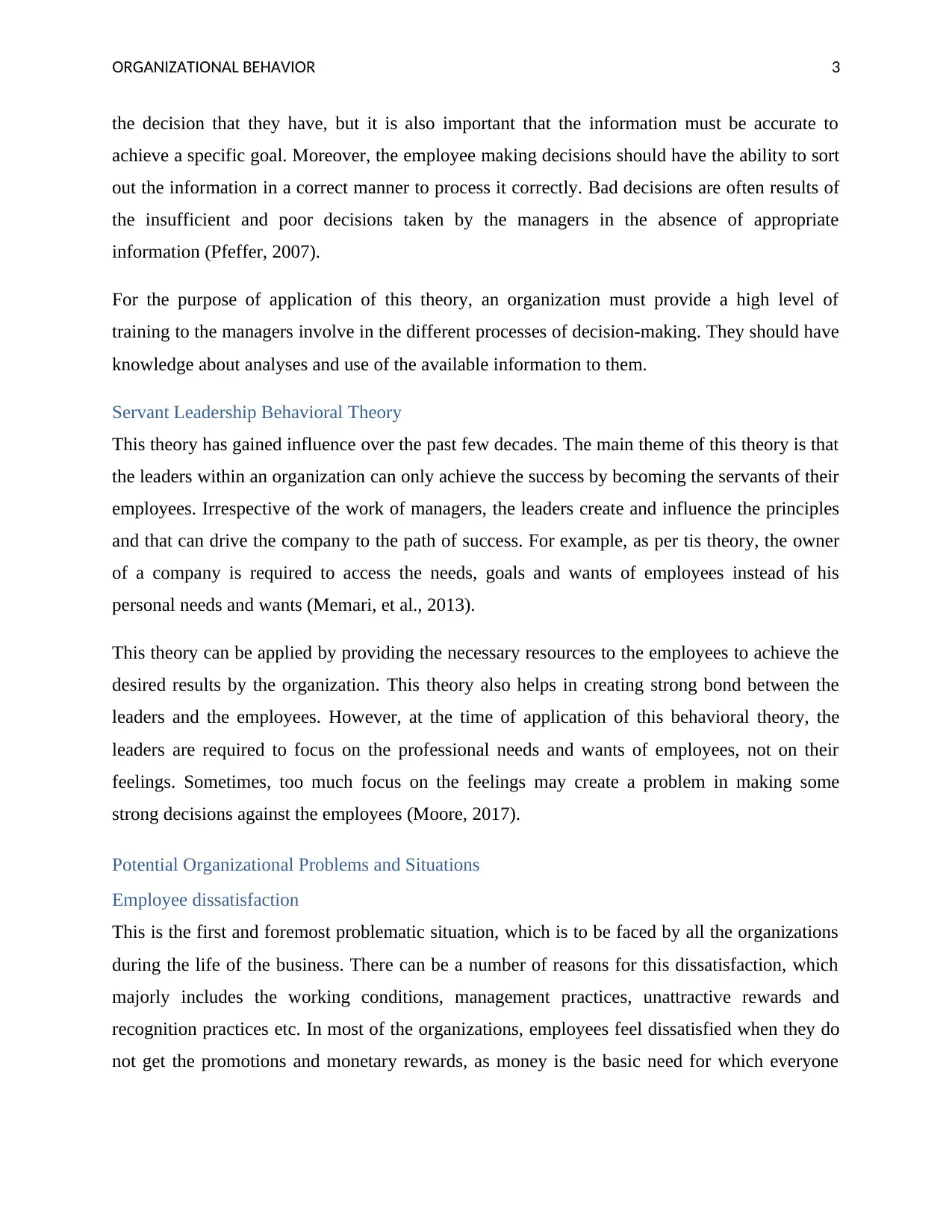
ORGANIZATIONAL BEHAVIOR 3
the decision that they have, but it is also important that the information must be accurate to
achieve a specific goal. Moreover, the employee making decisions should have the ability to sort
out the information in a correct manner to process it correctly. Bad decisions are often results of
the insufficient and poor decisions taken by the managers in the absence of appropriate
information (Pfeffer, 2007).
For the purpose of application of this theory, an organization must provide a high level of
training to the managers involve in the different processes of decision-making. They should have
knowledge about analyses and use of the available information to them.
Servant Leadership Behavioral Theory
This theory has gained influence over the past few decades. The main theme of this theory is that
the leaders within an organization can only achieve the success by becoming the servants of their
employees. Irrespective of the work of managers, the leaders create and influence the principles
and that can drive the company to the path of success. For example, as per tis theory, the owner
of a company is required to access the needs, goals and wants of employees instead of his
personal needs and wants (Memari, et al., 2013).
This theory can be applied by providing the necessary resources to the employees to achieve the
desired results by the organization. This theory also helps in creating strong bond between the
leaders and the employees. However, at the time of application of this behavioral theory, the
leaders are required to focus on the professional needs and wants of employees, not on their
feelings. Sometimes, too much focus on the feelings may create a problem in making some
strong decisions against the employees (Moore, 2017).
Potential Organizational Problems and Situations
Employee dissatisfaction
This is the first and foremost problematic situation, which is to be faced by all the organizations
during the life of the business. There can be a number of reasons for this dissatisfaction, which
majorly includes the working conditions, management practices, unattractive rewards and
recognition practices etc. In most of the organizations, employees feel dissatisfied when they do
not get the promotions and monetary rewards, as money is the basic need for which everyone
the decision that they have, but it is also important that the information must be accurate to
achieve a specific goal. Moreover, the employee making decisions should have the ability to sort
out the information in a correct manner to process it correctly. Bad decisions are often results of
the insufficient and poor decisions taken by the managers in the absence of appropriate
information (Pfeffer, 2007).
For the purpose of application of this theory, an organization must provide a high level of
training to the managers involve in the different processes of decision-making. They should have
knowledge about analyses and use of the available information to them.
Servant Leadership Behavioral Theory
This theory has gained influence over the past few decades. The main theme of this theory is that
the leaders within an organization can only achieve the success by becoming the servants of their
employees. Irrespective of the work of managers, the leaders create and influence the principles
and that can drive the company to the path of success. For example, as per tis theory, the owner
of a company is required to access the needs, goals and wants of employees instead of his
personal needs and wants (Memari, et al., 2013).
This theory can be applied by providing the necessary resources to the employees to achieve the
desired results by the organization. This theory also helps in creating strong bond between the
leaders and the employees. However, at the time of application of this behavioral theory, the
leaders are required to focus on the professional needs and wants of employees, not on their
feelings. Sometimes, too much focus on the feelings may create a problem in making some
strong decisions against the employees (Moore, 2017).
Potential Organizational Problems and Situations
Employee dissatisfaction
This is the first and foremost problematic situation, which is to be faced by all the organizations
during the life of the business. There can be a number of reasons for this dissatisfaction, which
majorly includes the working conditions, management practices, unattractive rewards and
recognition practices etc. In most of the organizations, employees feel dissatisfied when they do
not get the promotions and monetary rewards, as money is the basic need for which everyone
Paraphrase This Document
Need a fresh take? Get an instant paraphrase of this document with our AI Paraphraser
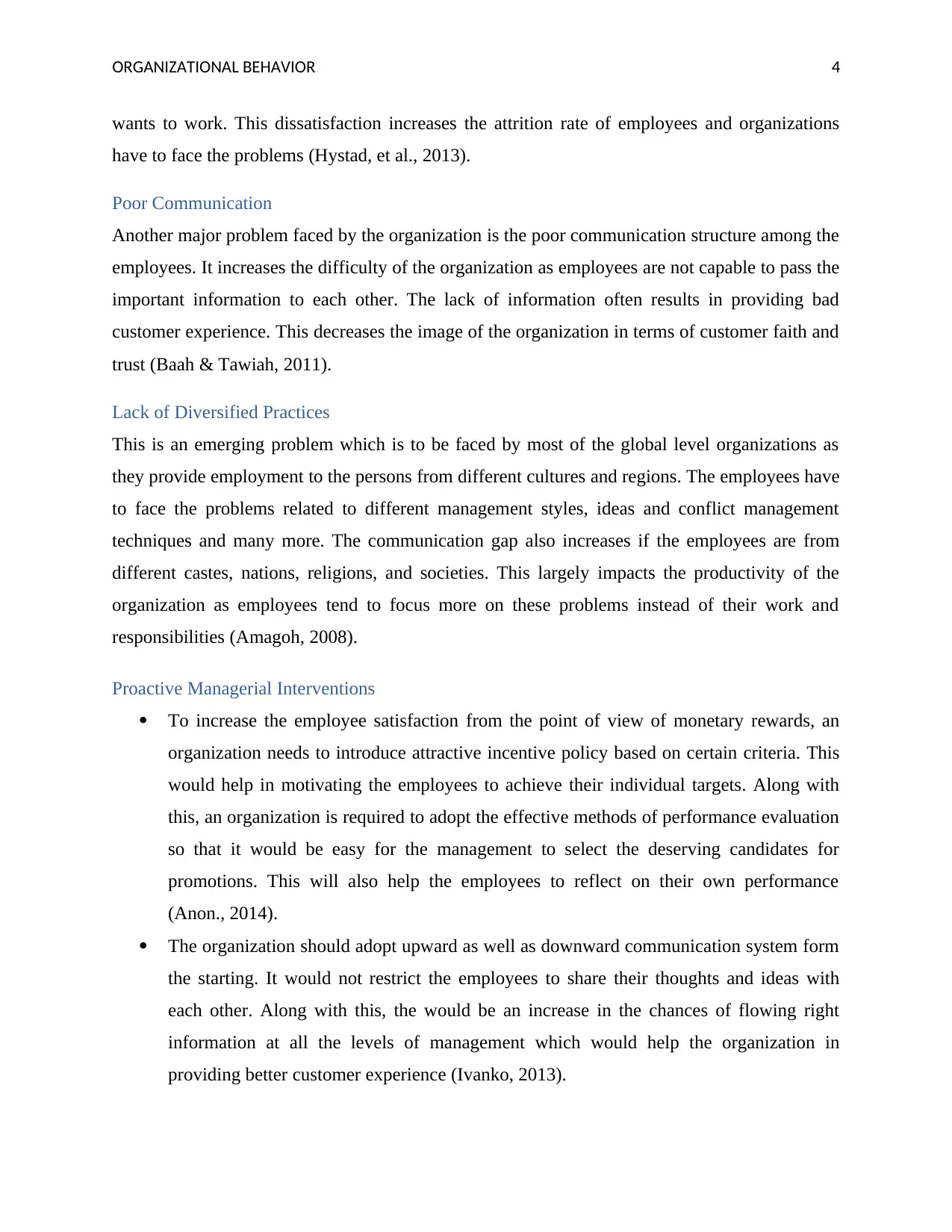
ORGANIZATIONAL BEHAVIOR 4
wants to work. This dissatisfaction increases the attrition rate of employees and organizations
have to face the problems (Hystad, et al., 2013).
Poor Communication
Another major problem faced by the organization is the poor communication structure among the
employees. It increases the difficulty of the organization as employees are not capable to pass the
important information to each other. The lack of information often results in providing bad
customer experience. This decreases the image of the organization in terms of customer faith and
trust (Baah & Tawiah, 2011).
Lack of Diversified Practices
This is an emerging problem which is to be faced by most of the global level organizations as
they provide employment to the persons from different cultures and regions. The employees have
to face the problems related to different management styles, ideas and conflict management
techniques and many more. The communication gap also increases if the employees are from
different castes, nations, religions, and societies. This largely impacts the productivity of the
organization as employees tend to focus more on these problems instead of their work and
responsibilities (Amagoh, 2008).
Proactive Managerial Interventions
To increase the employee satisfaction from the point of view of monetary rewards, an
organization needs to introduce attractive incentive policy based on certain criteria. This
would help in motivating the employees to achieve their individual targets. Along with
this, an organization is required to adopt the effective methods of performance evaluation
so that it would be easy for the management to select the deserving candidates for
promotions. This will also help the employees to reflect on their own performance
(Anon., 2014).
The organization should adopt upward as well as downward communication system form
the starting. It would not restrict the employees to share their thoughts and ideas with
each other. Along with this, the would be an increase in the chances of flowing right
information at all the levels of management which would help the organization in
providing better customer experience (Ivanko, 2013).
wants to work. This dissatisfaction increases the attrition rate of employees and organizations
have to face the problems (Hystad, et al., 2013).
Poor Communication
Another major problem faced by the organization is the poor communication structure among the
employees. It increases the difficulty of the organization as employees are not capable to pass the
important information to each other. The lack of information often results in providing bad
customer experience. This decreases the image of the organization in terms of customer faith and
trust (Baah & Tawiah, 2011).
Lack of Diversified Practices
This is an emerging problem which is to be faced by most of the global level organizations as
they provide employment to the persons from different cultures and regions. The employees have
to face the problems related to different management styles, ideas and conflict management
techniques and many more. The communication gap also increases if the employees are from
different castes, nations, religions, and societies. This largely impacts the productivity of the
organization as employees tend to focus more on these problems instead of their work and
responsibilities (Amagoh, 2008).
Proactive Managerial Interventions
To increase the employee satisfaction from the point of view of monetary rewards, an
organization needs to introduce attractive incentive policy based on certain criteria. This
would help in motivating the employees to achieve their individual targets. Along with
this, an organization is required to adopt the effective methods of performance evaluation
so that it would be easy for the management to select the deserving candidates for
promotions. This will also help the employees to reflect on their own performance
(Anon., 2014).
The organization should adopt upward as well as downward communication system form
the starting. It would not restrict the employees to share their thoughts and ideas with
each other. Along with this, the would be an increase in the chances of flowing right
information at all the levels of management which would help the organization in
providing better customer experience (Ivanko, 2013).
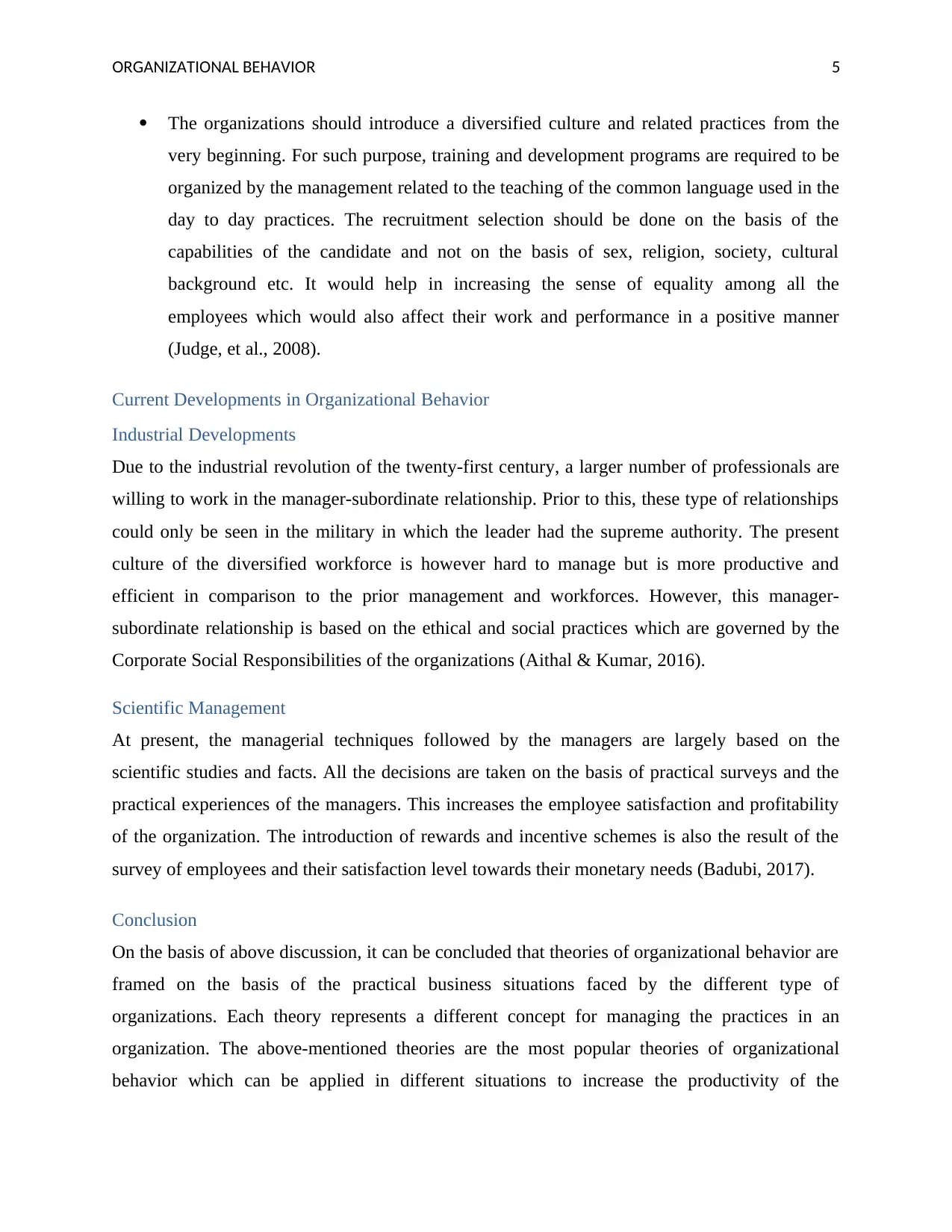
ORGANIZATIONAL BEHAVIOR 5
The organizations should introduce a diversified culture and related practices from the
very beginning. For such purpose, training and development programs are required to be
organized by the management related to the teaching of the common language used in the
day to day practices. The recruitment selection should be done on the basis of the
capabilities of the candidate and not on the basis of sex, religion, society, cultural
background etc. It would help in increasing the sense of equality among all the
employees which would also affect their work and performance in a positive manner
(Judge, et al., 2008).
Current Developments in Organizational Behavior
Industrial Developments
Due to the industrial revolution of the twenty-first century, a larger number of professionals are
willing to work in the manager-subordinate relationship. Prior to this, these type of relationships
could only be seen in the military in which the leader had the supreme authority. The present
culture of the diversified workforce is however hard to manage but is more productive and
efficient in comparison to the prior management and workforces. However, this manager-
subordinate relationship is based on the ethical and social practices which are governed by the
Corporate Social Responsibilities of the organizations (Aithal & Kumar, 2016).
Scientific Management
At present, the managerial techniques followed by the managers are largely based on the
scientific studies and facts. All the decisions are taken on the basis of practical surveys and the
practical experiences of the managers. This increases the employee satisfaction and profitability
of the organization. The introduction of rewards and incentive schemes is also the result of the
survey of employees and their satisfaction level towards their monetary needs (Badubi, 2017).
Conclusion
On the basis of above discussion, it can be concluded that theories of organizational behavior are
framed on the basis of the practical business situations faced by the different type of
organizations. Each theory represents a different concept for managing the practices in an
organization. The above-mentioned theories are the most popular theories of organizational
behavior which can be applied in different situations to increase the productivity of the
The organizations should introduce a diversified culture and related practices from the
very beginning. For such purpose, training and development programs are required to be
organized by the management related to the teaching of the common language used in the
day to day practices. The recruitment selection should be done on the basis of the
capabilities of the candidate and not on the basis of sex, religion, society, cultural
background etc. It would help in increasing the sense of equality among all the
employees which would also affect their work and performance in a positive manner
(Judge, et al., 2008).
Current Developments in Organizational Behavior
Industrial Developments
Due to the industrial revolution of the twenty-first century, a larger number of professionals are
willing to work in the manager-subordinate relationship. Prior to this, these type of relationships
could only be seen in the military in which the leader had the supreme authority. The present
culture of the diversified workforce is however hard to manage but is more productive and
efficient in comparison to the prior management and workforces. However, this manager-
subordinate relationship is based on the ethical and social practices which are governed by the
Corporate Social Responsibilities of the organizations (Aithal & Kumar, 2016).
Scientific Management
At present, the managerial techniques followed by the managers are largely based on the
scientific studies and facts. All the decisions are taken on the basis of practical surveys and the
practical experiences of the managers. This increases the employee satisfaction and profitability
of the organization. The introduction of rewards and incentive schemes is also the result of the
survey of employees and their satisfaction level towards their monetary needs (Badubi, 2017).
Conclusion
On the basis of above discussion, it can be concluded that theories of organizational behavior are
framed on the basis of the practical business situations faced by the different type of
organizations. Each theory represents a different concept for managing the practices in an
organization. The above-mentioned theories are the most popular theories of organizational
behavior which can be applied in different situations to increase the productivity of the
⊘ This is a preview!⊘
Do you want full access?
Subscribe today to unlock all pages.

Trusted by 1+ million students worldwide
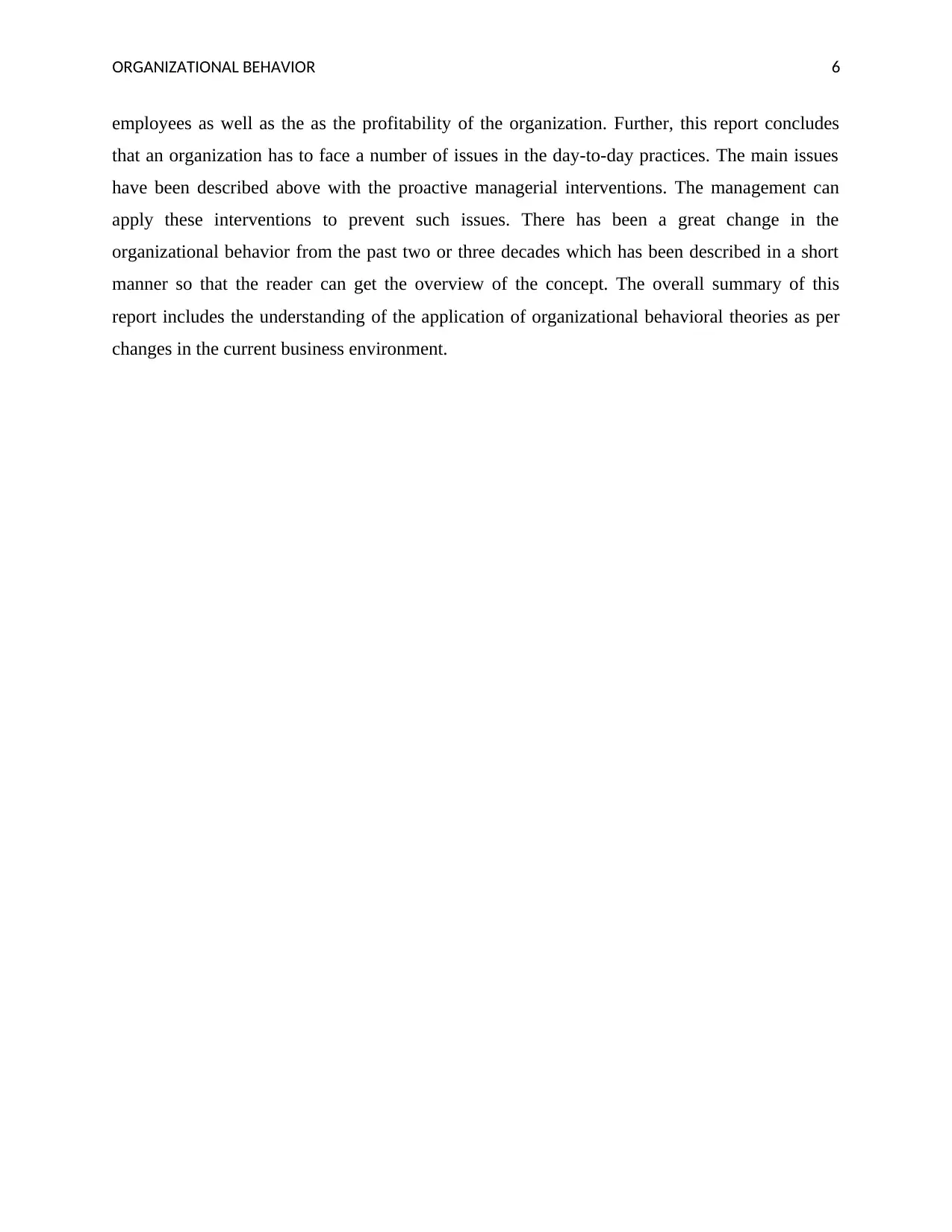
ORGANIZATIONAL BEHAVIOR 6
employees as well as the as the profitability of the organization. Further, this report concludes
that an organization has to face a number of issues in the day-to-day practices. The main issues
have been described above with the proactive managerial interventions. The management can
apply these interventions to prevent such issues. There has been a great change in the
organizational behavior from the past two or three decades which has been described in a short
manner so that the reader can get the overview of the concept. The overall summary of this
report includes the understanding of the application of organizational behavioral theories as per
changes in the current business environment.
employees as well as the as the profitability of the organization. Further, this report concludes
that an organization has to face a number of issues in the day-to-day practices. The main issues
have been described above with the proactive managerial interventions. The management can
apply these interventions to prevent such issues. There has been a great change in the
organizational behavior from the past two or three decades which has been described in a short
manner so that the reader can get the overview of the concept. The overall summary of this
report includes the understanding of the application of organizational behavioral theories as per
changes in the current business environment.
Paraphrase This Document
Need a fresh take? Get an instant paraphrase of this document with our AI Paraphraser
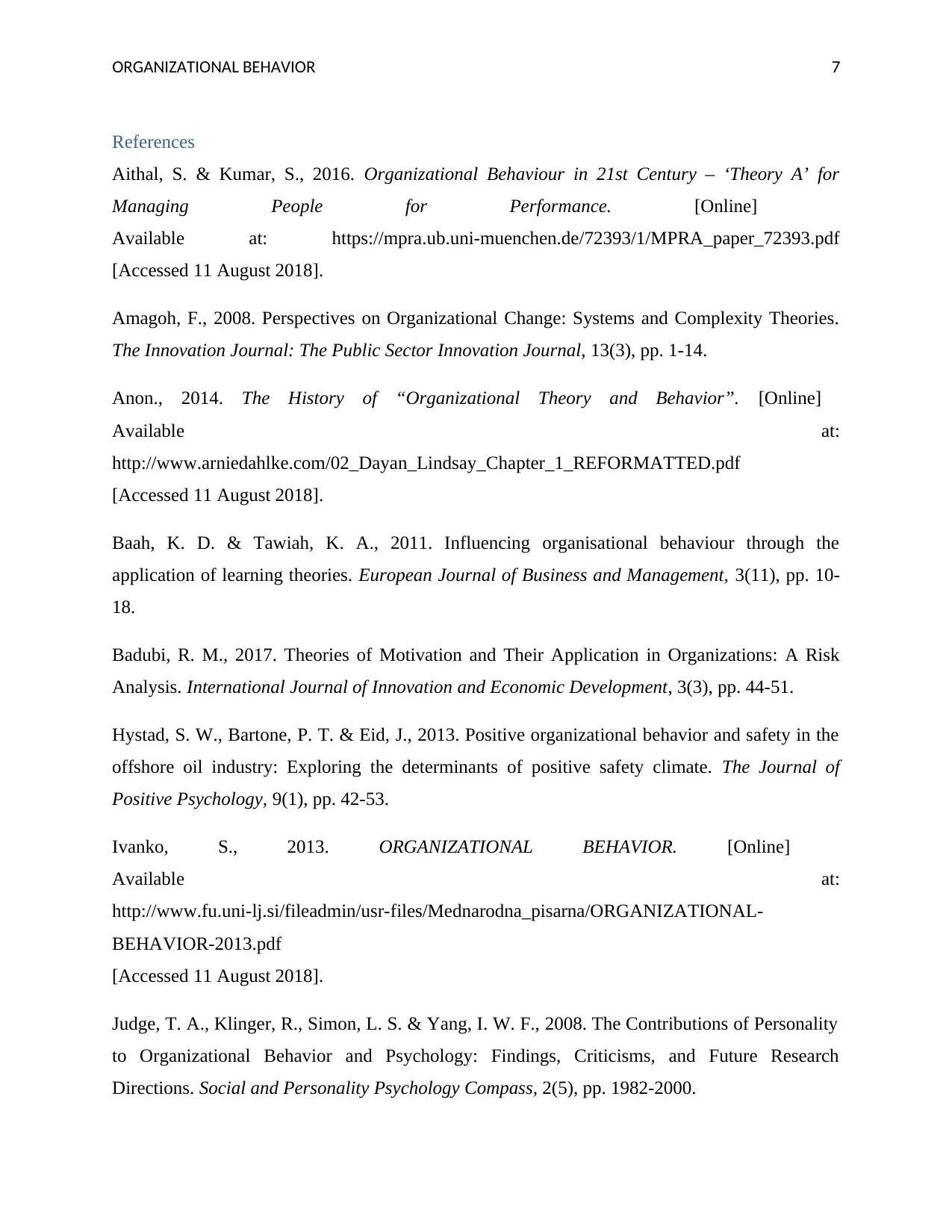
ORGANIZATIONAL BEHAVIOR 7
References
Aithal, S. & Kumar, S., 2016. Organizational Behaviour in 21st Century – ‘Theory A’ for
Managing People for Performance. [Online]
Available at: https://mpra.ub.uni-muenchen.de/72393/1/MPRA_paper_72393.pdf
[Accessed 11 August 2018].
Amagoh, F., 2008. Perspectives on Organizational Change: Systems and Complexity Theories.
The Innovation Journal: The Public Sector Innovation Journal, 13(3), pp. 1-14.
Anon., 2014. The History of “Organizational Theory and Behavior”. [Online]
Available at:
http://www.arniedahlke.com/02_Dayan_Lindsay_Chapter_1_REFORMATTED.pdf
[Accessed 11 August 2018].
Baah, K. D. & Tawiah, K. A., 2011. Influencing organisational behaviour through the
application of learning theories. European Journal of Business and Management, 3(11), pp. 10-
18.
Badubi, R. M., 2017. Theories of Motivation and Their Application in Organizations: A Risk
Analysis. International Journal of Innovation and Economic Development, 3(3), pp. 44-51.
Hystad, S. W., Bartone, P. T. & Eid, J., 2013. Positive organizational behavior and safety in the
offshore oil industry: Exploring the determinants of positive safety climate. The Journal of
Positive Psychology, 9(1), pp. 42-53.
Ivanko, S., 2013. ORGANIZATIONAL BEHAVIOR. [Online]
Available at:
http://www.fu.uni-lj.si/fileadmin/usr-files/Mednarodna_pisarna/ORGANIZATIONAL-
BEHAVIOR-2013.pdf
[Accessed 11 August 2018].
Judge, T. A., Klinger, R., Simon, L. S. & Yang, I. W. F., 2008. The Contributions of Personality
to Organizational Behavior and Psychology: Findings, Criticisms, and Future Research
Directions. Social and Personality Psychology Compass, 2(5), pp. 1982-2000.
References
Aithal, S. & Kumar, S., 2016. Organizational Behaviour in 21st Century – ‘Theory A’ for
Managing People for Performance. [Online]
Available at: https://mpra.ub.uni-muenchen.de/72393/1/MPRA_paper_72393.pdf
[Accessed 11 August 2018].
Amagoh, F., 2008. Perspectives on Organizational Change: Systems and Complexity Theories.
The Innovation Journal: The Public Sector Innovation Journal, 13(3), pp. 1-14.
Anon., 2014. The History of “Organizational Theory and Behavior”. [Online]
Available at:
http://www.arniedahlke.com/02_Dayan_Lindsay_Chapter_1_REFORMATTED.pdf
[Accessed 11 August 2018].
Baah, K. D. & Tawiah, K. A., 2011. Influencing organisational behaviour through the
application of learning theories. European Journal of Business and Management, 3(11), pp. 10-
18.
Badubi, R. M., 2017. Theories of Motivation and Their Application in Organizations: A Risk
Analysis. International Journal of Innovation and Economic Development, 3(3), pp. 44-51.
Hystad, S. W., Bartone, P. T. & Eid, J., 2013. Positive organizational behavior and safety in the
offshore oil industry: Exploring the determinants of positive safety climate. The Journal of
Positive Psychology, 9(1), pp. 42-53.
Ivanko, S., 2013. ORGANIZATIONAL BEHAVIOR. [Online]
Available at:
http://www.fu.uni-lj.si/fileadmin/usr-files/Mednarodna_pisarna/ORGANIZATIONAL-
BEHAVIOR-2013.pdf
[Accessed 11 August 2018].
Judge, T. A., Klinger, R., Simon, L. S. & Yang, I. W. F., 2008. The Contributions of Personality
to Organizational Behavior and Psychology: Findings, Criticisms, and Future Research
Directions. Social and Personality Psychology Compass, 2(5), pp. 1982-2000.
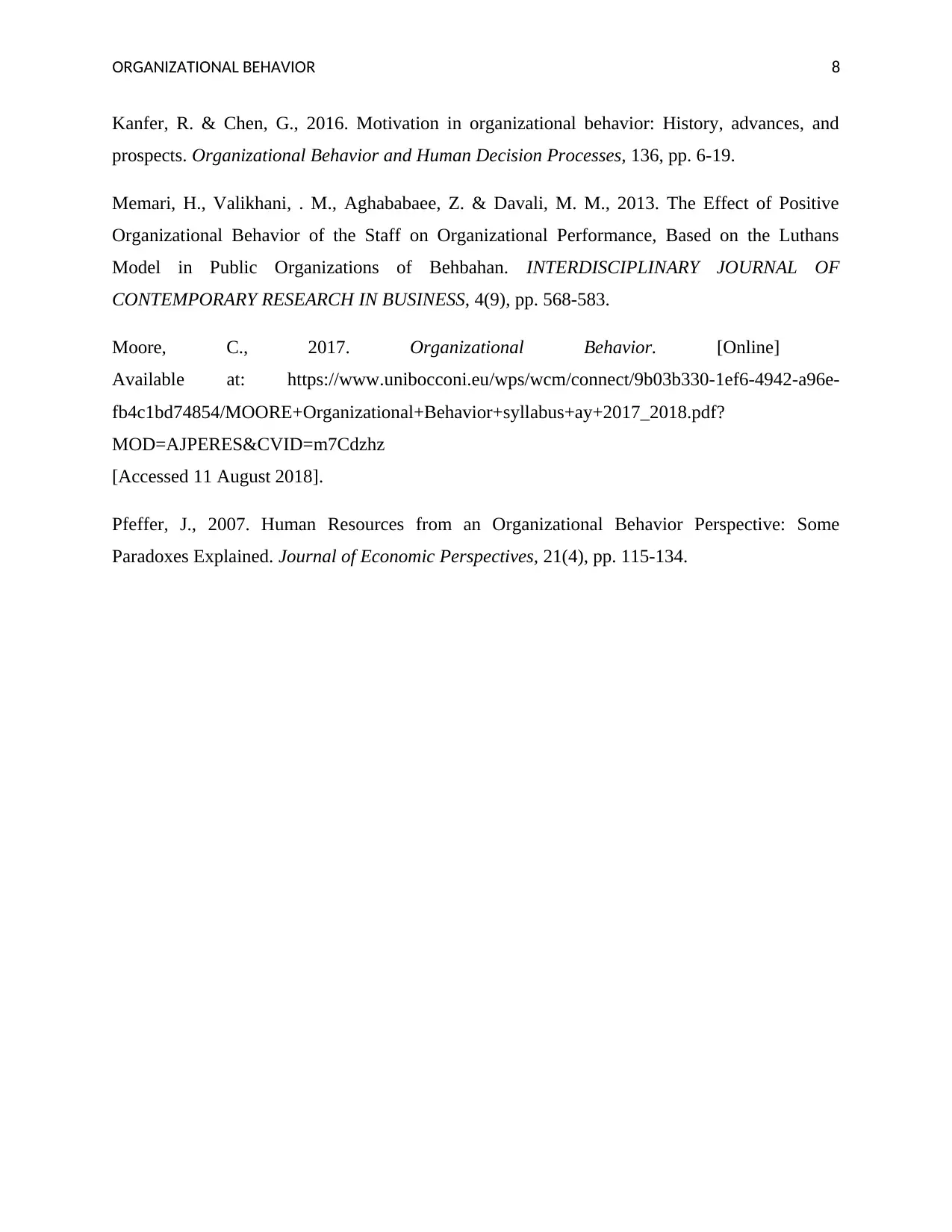
ORGANIZATIONAL BEHAVIOR 8
Kanfer, R. & Chen, G., 2016. Motivation in organizational behavior: History, advances, and
prospects. Organizational Behavior and Human Decision Processes, 136, pp. 6-19.
Memari, H., Valikhani, . M., Aghababaee, Z. & Davali, M. M., 2013. The Effect of Positive
Organizational Behavior of the Staff on Organizational Performance, Based on the Luthans
Model in Public Organizations of Behbahan. INTERDISCIPLINARY JOURNAL OF
CONTEMPORARY RESEARCH IN BUSINESS, 4(9), pp. 568-583.
Moore, C., 2017. Organizational Behavior. [Online]
Available at: https://www.unibocconi.eu/wps/wcm/connect/9b03b330-1ef6-4942-a96e-
fb4c1bd74854/MOORE+Organizational+Behavior+syllabus+ay+2017_2018.pdf?
MOD=AJPERES&CVID=m7Cdzhz
[Accessed 11 August 2018].
Pfeffer, J., 2007. Human Resources from an Organizational Behavior Perspective: Some
Paradoxes Explained. Journal of Economic Perspectives, 21(4), pp. 115-134.
Kanfer, R. & Chen, G., 2016. Motivation in organizational behavior: History, advances, and
prospects. Organizational Behavior and Human Decision Processes, 136, pp. 6-19.
Memari, H., Valikhani, . M., Aghababaee, Z. & Davali, M. M., 2013. The Effect of Positive
Organizational Behavior of the Staff on Organizational Performance, Based on the Luthans
Model in Public Organizations of Behbahan. INTERDISCIPLINARY JOURNAL OF
CONTEMPORARY RESEARCH IN BUSINESS, 4(9), pp. 568-583.
Moore, C., 2017. Organizational Behavior. [Online]
Available at: https://www.unibocconi.eu/wps/wcm/connect/9b03b330-1ef6-4942-a96e-
fb4c1bd74854/MOORE+Organizational+Behavior+syllabus+ay+2017_2018.pdf?
MOD=AJPERES&CVID=m7Cdzhz
[Accessed 11 August 2018].
Pfeffer, J., 2007. Human Resources from an Organizational Behavior Perspective: Some
Paradoxes Explained. Journal of Economic Perspectives, 21(4), pp. 115-134.
⊘ This is a preview!⊘
Do you want full access?
Subscribe today to unlock all pages.

Trusted by 1+ million students worldwide
1 out of 9
Related Documents
Your All-in-One AI-Powered Toolkit for Academic Success.
+13062052269
info@desklib.com
Available 24*7 on WhatsApp / Email
![[object Object]](/_next/static/media/star-bottom.7253800d.svg)
Unlock your academic potential
Copyright © 2020–2025 A2Z Services. All Rights Reserved. Developed and managed by ZUCOL.





